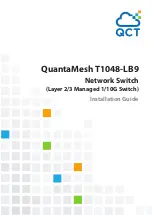
406
C
HAPTER
16: T
RAFFIC
M
ANAGEMENT
Priority Output Queues
One primary way in which the CoreBuilder 9000 ATM Enterprise Switch
controls output data loss is by prioritizing the output data. A data frame
for which certain losses or delays in transmission can be tolerated
according to its QoS is designated as lower priority data. For example,
voice data is sensitive to loss and delay, and is therefore classified as
high-priority data. The ATM-Layer Processor (ALP) assigns priorities to
cells according to a priority decision made by the ATM Switch Fabric
Module CPU. The ALP routes the data to the priority queues according to
its priority.
In Figure 27, high priority data is protected by maintaining three output
queues for each subport, corresponding to high-to-low priority levels. The
queues are maintained in the Cell RAM, which has a total capacity of 8K
cells per OC-12c/STM-4 channel.
The high-priority data is maintained in the queue at a higher threshold
than the low priority data so that, in case of congestion, the low priority
cells are dropped first.
Back Pressure Cell Storage
Back Pressure Cell Storage controls loss of output data. This overall
strategy works with the priority output queues on the CoreBuilder 9000
ATM Enterprise Switch, as well as with queues in the ATM Switch Fabric
Module, to provide extra protection against loss of output data.
Содержание CoreBuilder 9000
Страница 18: ......
Страница 36: ...36 CHAPTER 1 OVERVIEW...
Страница 44: ......
Страница 152: ...152 CHAPTER 6 MANAGING NETWORK INTERFACES...
Страница 224: ...224 CHAPTER 8 VIEWING STATISTICS...
Страница 306: ......
Страница 320: ...320 CHAPTER 10 ATM NETWORK BASICS...
Страница 332: ...332 CHAPTER 11 NETWORK INTERFACE MANAGEMENT...
Страница 348: ...348 CHAPTER 12 E IISP PROTOCOL...
Страница 374: ...374 CHAPTER 14 ATM SWITCHING...
Страница 410: ...410 CHAPTER 16 TRAFFIC MANAGEMENT...
Страница 426: ......
Страница 450: ...450 APPENDIX D TECHNICAL SUPPORT...
Страница 454: ...454 GLOSSARY...
















































